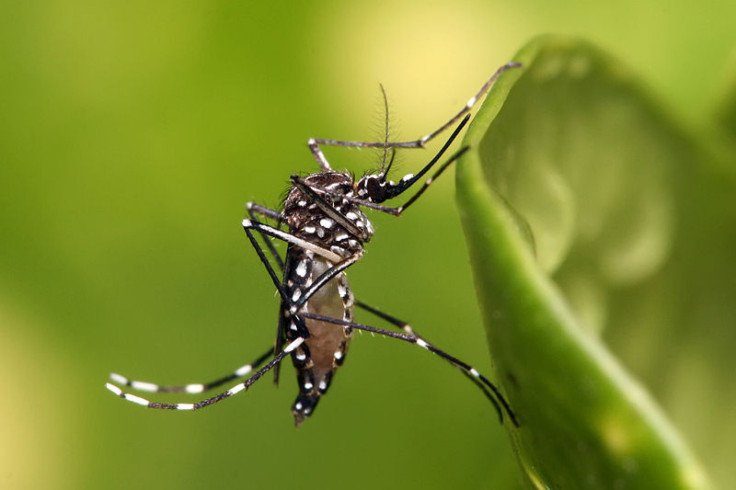Yellow Fever Mosquito, Aedes Aegypti, Found In California, Is ‘Very Difficult To Control’

Charge the bug zappers, because an invasive species of mosquito known to carry yellow fever and dengue fever was spotted in various parts of California’s Central Valley over the past few months.
Aedes aegypti, otherwise known as the yellow-fever mosquito, is a dark mosquito with white markings and bands around its legs. According to The Associated Press, it has a reputation for preferring humans to lower orders of animals, bites in the daytime and needs just a teaspoon of water to lay its eggs.
Authorities first detected the mosquito in Madera and Clovis in June. In August, it was identified in San Mateo County near San Francisco, and, as of last week, the insect was seen in Fresno.
The yellow-fever mosquito originated in Africa but is now found throughout tropical and subtropical regions of the world. The rise in global trade in the last few centuries brought the mosquito to areas of the world where the pest didn’t previously exist. In California, health officials believe the disease-carrying mosquitoes arrived here as eggs on imported containers.
Preliminary results of genetic testing on yellow-fever mosquitoes show that they are probably from Central America, the SF Gate noted.
Vector control agents worry that if the yellow-fever mosquito isn't contained, it could pose a major risk to the public.
"If it gets away, it will change the way we live in California,” Tim Phillips of the Fresno Mosquito and Vector Control District told the San Francisco Chronicle. "You may not be able to sit on your patio and enjoy a cup of coffee during the day without getting bit."
The Chronicle also noted that both dengue and yellow fever are spread only by mosquito bites. Neither virus can pass from human to human.
"It's very difficult to control because of its biology," Steve Mulligan, who is working to contain the outbreak of yellow-fever mosquitoes in Clovis, told Associated Press. "They like humans and will come inside the house. We're trying hard to eliminate it."
Yellow fever, named for the jaundicing affect it can have on some patients, is a viral hemorrhagic fever spread by the bite of infected mosquitoes. Mosquitoes get the virus from feeding on infected primates, and then pass the virus along to other primates.
Most people who become infected with the virus don’t show symptoms or exhibit only mild illness. For those who do become ill, the U.S. Centers for Disease Control and Prevention notes the initial symptoms of yellow fever include fever, chills, back pain, severe headache, body ache, nausea, vomiting and fatigue. About 15 percent of yellow-fever cases develop into more severe forms of the disease.
People who suffer severe cases of yellow fever experience high temperature, jaundice, bleeding and, eventually, organ failure.
According to the World Health Organization, or WHO, the majority of cases and deaths from yellow fever occur in sub-Saharan Africa. The virus is considered a threat in 32 African countries, putting 610 million people in both urban and rural areas at risk of the disease.
Additionally, the virus is endemic to 10 South and Central American countries and several islands in the Caribbean.
Yellow-fever cases rarely surface in the U.S. Since 1970, there have been only nine reported cases of yellow fever here, all in unvaccinated travelers from West Africa or South America. As Medical Daily noted, Americans are not typically vaccinated for yellow fever unless they are traveling to areas where the yellow-fever mosquito is endemic.
Dengue fever, caused by a virus similar to that of yellow fever, also produces similar symptoms. Additionally, people who contract dengue fever also develop a skin rash like that found with measles.
Dengue fever was eradicated in the U.S. for nearly 60 years through mosquito-control spraying and prevention campaigns, according to Al Jazeera. But since the turn of the century, there have been outbreaks in Hawaii, Texas and Florida’s Key West that could signal the virus is again gaining a foothold in the U.S.
Last month in Florida, at least 20 people contracted dengue fever. Health officials were able to contain the outbreak, but warn that the virus could return if people don’t wear repellent and drain any standing water near their homes.
Just because the mosquito can carry the yellow fever and dengue fever viruses, doesn’t mean it’s already infected. According to NBC San Diego, none of the mosquitoes that have been trapped and tested by health officials in California's Central Valley carried the diseases.
Fortunately, experts say the risk of contracting yellow fever in California, even in the presence of Aedes aegypti, is small. A bigger threat to public health in California comes from the West Nile virus, which is also spread by mosquitoes. This year alone, there have been 275 cases of West Nile in the Golden State, seven of them fatal.
Most people who become infected with West Nile won’t develop symptoms. About 20 percent will experience fever, body aches, joint pain, diarrhea and headaches. Less than 1 percent will develop a serious neurologic illness such as meningitis or encephalitis.
© Copyright IBTimes 2024. All rights reserved.






















